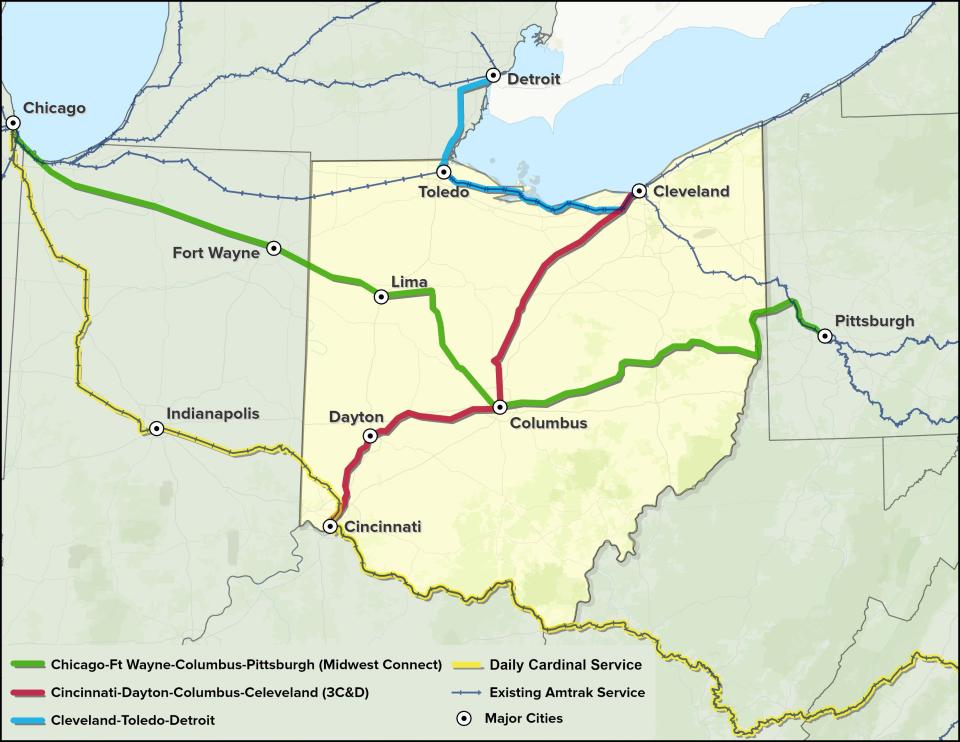Study: New Amtrak service would create millions in economic benefits to Greater Columbus
An economic impact study on an Amtrak route that would serve Columbus estimates that the initial investment in the region would generate between $36 million and $48 million, with $22 million to $29 million in wages for local workers.
The study commissioned by the non-profit rail advocacy group All Aboard Ohio also found that ongoing ridership would generate $3.9 million to $7.2 million in new wages a year.
The study's findings were presented Wednesday at the Mid-Ohio Regional Planning Commission's headquarters in the Brewery District.

In December, the Federal Railroad Administration said Ohio is in line for Amtrak service expansion, with officials are looking at four corridors:
Cincinnati-Dayton-Columbus-Cleveland
Chicago-Fort Wayne-Columbus-Pittsburgh, including Lima, Kenton, Marysville, Newark, Cochocton, Newcomerstown, Uhrichsville and Steubenville.
Cleveland-Toledo-Detroit
Increasing Amtrak's current route frequency to Cincinnati from New York, Washington, D.C., and Chicago.
The federal government provided $500,000 for planning for each route.
Service isn't expected to come to Columbus until 2030 at the earliest. But planning continues as work is done to prepare cost estimates to see what state and local governments would have to come up with to match federal funds in future planning rounds.
"This is going to be a transformative step in Ohio," said John Esterly, an All Aboard Ohio board member.
All Aboard Ohio brought in Scioto Analysis to do an economic impact study for Columbus on the Cincinnati-Dayton- Columbus- Cleveland line. The study can be found at allaboardohio.org.
Rob Moore of Scioto Analysis said annual ridership in Columbus would be 133,000 to 268,000 a year. The new Cincinnati-Dayton-Columbus-Cleveland service would create 400-520 initially, with 60 to 110 jobs a year after that.
The economic impact in Greater Columbus would be $36 million to $48 million at first, with a $9 million to $16 million annual impact a year after that.
Moore said that the study estimates that the initial investment for service between Cincinnati, Dayton, Columbus and Cleveland would generate $106 million to $107 million to the gross state product. After that, the corridor would continue to contribute $25 to $47 million to gross state product per year through ridership.
Service also would help the environment and help reduce the number of vehicle crashes because of fewer automobile miles traveled, he said.
Passenger trains would share track with freight trains, and freight trains get priority. Esterly said there are concerns about capacity, but he said there is room for Amtrak.
"We don't run a lot of freight trains during the day," Esterly said. "We can work out these problems."
Marc Magliari, an Amtrak spokesman who attended the meeting, said Amtrak recognizes that trains need to be competitive with freeways. "Speed's important," he said. But he said what drives ridership is reliability, frequency and competitive fares.
Esterly said passenger trains reach speeds of 110 mph in corridors such as the one between Detroit and Chicago.
Erin Rosiello, All Aboard Ohio's chair, said, "You're not going to replace cars, that's never going to happen."
But trains would help reduce traffic congestion, and provide options for people without cars or driver's licenses, she said.
The last year Amtrak passed through Columbus was 1979, a route between Kansas City, Missouri, and New York City.
mferench@dispatch.com
@MarkFerenchik
This article originally appeared on The Columbus Dispatch: Study says new Amtrak service would generate jobs, money for Ohio

